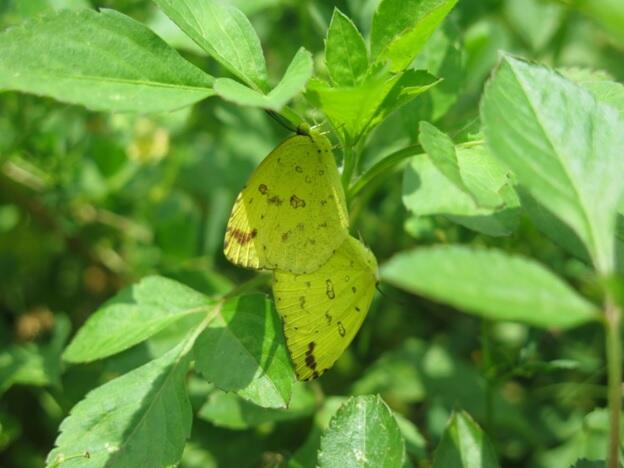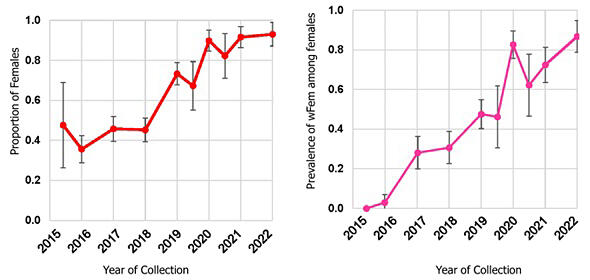A research group led by Assistant Professor Mai Miyata of the Faculty of Engineering at the University of Fukui, Professor Masashi Nomura of the Graduate School of Horticulture at Chiba University, and Deputy Leader Daisuke Kageyama of the Institute of Agrobiological Sciences at the National Agriculture and Food Research Organization (NARO) has announced that they successfully observed the rapid spread of a Wolbachia species, a bacterium that feminizes its host, in the pierid butterfly (Eurema hecabe) on Ishigaki Island. The group found that the female population changed from approximately 50%-93.1% in just 4 years. These findings are expected to help understand the impact of sex ratio changes caused by bacteria and were published in the May 20 issue of the international journal Current Biology.

Provided by Assistant Professor Mai Miyata, the University of Fukui
Wolbachia species have been found in many insects and are known to manipulate the reproduction of host insects. As a result "male-killing" and "feminization" occur in various insects. Because these bacteria cannot survive outside the host cells and are spread among the host via mother to offspring transmission, it is believed that Wolbachia species select females for survival. Although previous reports have documented the phenomenon of sex ratios shifting to a state biased toward females due to male-killing Wolbachia species, these reports have described observations after the sex ratio became female-predominant, and the process of sex ratio shifting has been considered difficult to capture.
In 2011, it was reported that the pierid butterfly E. hecabe, found in a southern part of Japan below Amami-Oshima Island is feminized because of infection by the wFem strain of Wolbachia. Currently, the prevalence of wFem is only 8%. Therefore, the research group began observing the wFem prevalence and sex ratio in a pierid butterfly population on Ishigaki Island in 2015, with the hypothesis that wFem prevalence would increase. A total of 1392 pierid butterflies were collected on Ishigaki Island between 2015 and 2022, and sex ratios were recorded. The results showed that the sex ratio remained almost 1:1 from 2015 to 2018 and became biased progressively as the female population exceeded 70% in 2019 and reached 93.1% in 2022. PCR analysis of all individuals collected to detect the presence of wFem showed that the wFem prevalence started to increase in 2017, and 87% of females had wFem by 2022. Females collected in the field in 2019 were brought back to the laboratory to compare the sex ratio among the next generation, and the result showed that the sex ratio was predominantly female. Accordingly, the spread of Wolbachia resulted in the near complete feminization of the E. hecabe population on Ishigaki Island within a remarkably brief period of 4 years.
Moving forward, the research group will continue to survey pierid butterflies to determine whether they will acquire resistance to reproductive manipulation by Wolbachia or become extinct. In the nymphalid butterfly Hypolimnas bolina, the strongly female-biased sex ratio caused by the spread of the male-killing Wolbachia species reverted to 1:1 in several years.

Provided by Assistant Professor Mai Miyata, the University of Fukui
Assistant Professor Miyata commented, "We conducted surveys last year and this year and hope to report the results in the future. We are also going to analyze the samples that we have collected so far with the hope that the impact of biased feminization on the population and its evolution can be revealed. For example, in a population with a strongly female-biased sex ratio, an increased number of females might be unable to spawn, or the number of remaining males might be so small that they are exhausted and their organs are affected. We hope that we will be able to answer these questions by continuing the surveys, including field research."
Journal Information
Publication: Current Biology
Title: Rapid spread of a vertically transmitted symbiont induces drastic shifts in butterfly sex ratio
DOI: 10.1016/j.cub.2024.04.027
This article has been translated by JST with permission from The Science News Ltd. (https://sci-news.co.jp/). Unauthorized reproduction of the article and photographs is prohibited.




